Recent Strategies in Nickel-Catalyzed C–H Bond Functionalization for Nitrogen-Containing Heterocycles
Abstract
:1. Introduction
2. Nickel-Catalyzed Intramolecular C–H Bond Functionalization
3. Nickel-Catalyzed Intermolecular C–H Bond Functionalization
4. Conclusions
Author Contributions
Funding
Data Availability Statement
Conflicts of Interest
Abbreviations
| IMes | 1,3-Bis(2,4,6-trimethylphenyl)-1,3-dihydro-2H-imidazol-2-ylidene |
| cod | 1,5-Cyclooctadiene |
| IPr | 1,3-Bis(2,6-diisopropylphenyl)imidazole-2-ylidene |
| dppe | 1,2-Bis(diphenylphosphino)ethane |
| dppp | 1,3-Bis(diphenylphosphino)propane |
| CMD | Concerted metalation deprotonation |
| MAD | Methylaluminum bis(2,6-di-tert-butyl 4-methylphenoxide) |
| SPO | Secondary phosphine oxide |
| JoSPOphos | (R)-1-[(R)-Tert-butylphosphinoyl]-2-[(R)-1-(diphenylphosphino)ethyl]ferrocene |
| CAN | Ceric ammonium nitrate |
| TEMPO | 2,2,6,6-Tetramethyl-1-piperidinyloxy |
| SET | Single electron transfer |
| acac | Acetylacetone |
| DMF | N,N-Dimethyl Formamide |
| SET | Single electron transfer |
| AdFL | 1,9-Di(1-adamantyl)-5-perfluorophenyldipyrrin |
| py | Pyridine |
| TrFBOX | Trityl-5-perfluorophenylbisoxazoline |
| dtbbpy | 4,4′-Di-tert-butyl-2,2′-bipyridine |
| ppy | (2-Pyridinyl)phenyl |
| THAB | Tetra-n-hexylammonium benzoate |
| TBAPF6 | Tetrabutylammonium hexafluorophosphate |
| dppf | 1,1′-Bis(diphenylphosphino)ferrocene |
| dme | Dimethyl ether |
References
- Kaur, N. Synthesis of three-membered and four-membered heterocycles with the assistance of photochemical reactions. J. Heterocycl. Chem. 2019, 56, 1141–1167. [Google Scholar] [CrossRef]
- Shiri, P. Novel hybrid molecules based on triazole-β-lactam as potential biological agents. Mini Rev. Med. Chem. 2021, 21, 536–553. [Google Scholar] [CrossRef] [PubMed]
- Meera, G.; Rohit, K.R.; Saranya, S.; Anilkumar, G. Microwave assisted synthesis of five membered nitrogen heterocycles. RSC Adv. 2020, 10, 36031–36041. [Google Scholar] [CrossRef] [PubMed]
- Shiri, P.; Amani, A.M.; Mayer-Gall, T.J. A recent overview on the synthesis of 1,4,5-trisubstituted 1,2,3-triazoles. Beilstein J. Org. Chem. 2021, 17, 1600–1628. [Google Scholar] [CrossRef]
- Obaid, R.J.; Mughal, E.U.; Naeem, N.; Al-Rooqi, M.M.; Sadiq, A.; Jassas, R.S.; Moussa, Z.; Ahmed, S.A. Pharmacological significance of nitrogen-containing five and six-membered heterocyclic scaffolds as potent cholinesterase inhibitors for drug discovery. Process Biochem. 2022, 120, 250–259. [Google Scholar]
- Kaur, N. Seven-membered N-heterocycles: Metal and nonmetal assisted synthesis. Synth. Commun. 2019, 49, 987–1030. [Google Scholar] [CrossRef]
- Namasivayam, V.; Vanangamudi, M.; Kramer, V.G.; Kurup, S.; Zhan, P.; Liu, X.; Kongsted, J.; Byrareddy, S.N. The Journey of HIV-1 non-nucleoside reverse transcriptase inhibitors (NNRTIs) from lab to clinic. J. Med. Chem. 2019, 62, 4851–4883. [Google Scholar] [CrossRef]
- Zha, G.F.; Preetham, H.D.; Rangappa, S.; Kumar, K.S.S.; Girish, Y.R.; Rakesh, K.P.; Ashrafizadeh, M.; Zarrabi, A.; Rangappa, K.S. Benzimidazole analogues as efficient arsenals in war against methicillin-resistance staphylococcus aureus (MRSA) and its SAR studies. Bioorg. Chem. 2021, 115, 105175. [Google Scholar] [CrossRef]
- Khan, E. Pyridine derivatives as biologically active precursors; organics and selected coordination complexes. ChemistrySelect 2021, 6, 3041–3064. [Google Scholar] [CrossRef]
- Heravi, M.M.; Zadsirjan, V. Prescribed drugs containing nitrogen heterocycles: An overview. RSC Adv. 2020, 10, 44247–44311. [Google Scholar]
- Yang, K.; Zhang, H.; Niu, B.; Tang, T.; Ge, H. Benzisothiazol-3-ones through a metal-free intramolecular N–S bond formation. Eur. J. Org. Chem. 2018, 2018, 5520–5523. [Google Scholar] [CrossRef]
- Josien, H.; Bom, D.; Curran, D.P.; Zheng, Y.H.; Chou, T.C. 7-Silylcamptothecins (silatecans): A new family of camptothecin antitumor agents. Bioorg. Med. Chem. Lett. 1997, 7, 3189–3194. [Google Scholar] [CrossRef]
- Hurst, M.; Lamb, H.M.; Scott, L.J.; Figgitt, D.P. Levofloxacin: An updated review of its use in the treatment of bacterial infections. Drugs 2002, 62, 2127–2167. [Google Scholar] [CrossRef] [PubMed]
- Dutta, U.; Maiti, S.; Bhattacharya, T.; Maiti, D. Arene diversification through distal C(sp2)–H functionalization. Science 2021, 372, eabd5992. [Google Scholar] [CrossRef]
- Li, B.; Ali, A.I.M.; Ge, H. Recent advances in using transition-metal-catalyzed C–H functionalization to build fluorescent materials. Chem 2020, 6, 2591–2657. [Google Scholar] [CrossRef]
- Dai, S.; Yang, K.; Luo, Y.; Xu, Z.; Li, Z.; Li, Z.Y.; Li, B.; Sun, X. Metal-free and Selectfluor-mediated diverse transformations of 2-alkylthiobenzamides to access 2,3-dihydrobenzothiazin-4-ones, benzoisothiazol-3-ones and 2-alkylthiobenzonitriles. Org. Chem. Front. 2022, 9, 4016–4022. [Google Scholar] [CrossRef]
- Yang, K.; Dai, S.; Li, Z.; Li, Z.Y.; Sun, X. Amide-assisted α-C(sp3)–H acyloxyation of organic sulfides to access α-acyloxy sulfides. Org. Chem. Front. 2021, 8, 4974–4979. [Google Scholar] [CrossRef]
- Yang, K.; Li, Y.; Song, M.; Dai, S.; Li, Z.; Sun, X. Metal-free direct C(sp3)-H functionalization of 2-alkylthiobenzoic acid to access 1,3-benzooxathiin-4-one. Chin. Chem. Lett. 2021, 32, 146–149. [Google Scholar] [CrossRef]
- Tang, L.; Hu, Q.; Yang, K.; Elsaid, M.; Liu, C.; Ge, H. Recent advances in direct α-C(sp3)–H bond functionalization of thioethers. Green Synth. Catal. 2022, 3, 203–211. [Google Scholar] [CrossRef]
- Yang, K.; Li, Z.; Liu, C.; Li, Y.; Hu, Q.; Elsaid, M.; Li, B.; Das, J.; Dang, Y.; Maiti, D.; et al. Ligand-promoted palladium-catalyzed bmethylene C–H arylation of primary aldehydes. Chem. Sci. 2022, 13, 5938–5943. [Google Scholar] [CrossRef]
- Feng, X.Q.; Wang, H.C.; Li, Z.; Tang, L.; Sun, X.; Yang, K. Transition-metal-catalyzed remote C–H functionalization of thioethers. RSC Adv. 2022, 12, 10835–10845. [Google Scholar] [CrossRef] [PubMed]
- Rago, A.J.; Dong, G. Synthesis of indoles, indolines, and carbazoles via palladium-catalyzed C–H activation. Green Synth. Catal. 2021, 2, 216–227. [Google Scholar] [CrossRef]
- Li, S.; Chen, Q.; Zhang, Z.M.; Zhang, J. Pd-catalyzed enantioselective intramolecular Heck reaction to access disubstituted dihydroisoquinolinone with a terminal olefin. Green Synth. Catal. 2021, 2, 374–376. [Google Scholar] [CrossRef]
- Yang, K.; Niu, B.; Ma, Z.; Wang, H.; Lawrence, B.; Ge, H. Silver-promoted site-selective intramolecular cyclization of 2-methylthiobenzamide through α-C(sp3)–H functionalization. J. Org. Chem. 2019, 84, 14045–14052. [Google Scholar] [CrossRef] [PubMed]
- Loup, J.; Dhawa, U.; Pesciaioli, F.; Wencel-Delord, J.; Ackermann, L. Enantioselective C–H activation with earth-abundant 3d transition metals. Angew. Chem. Int. Ed. 2019, 58, 2–18. [Google Scholar] [CrossRef]
- Yang, K.; Li, D.; Zhang, L.; Chen, Q.; Tang, T. Heterogeneous Co-catalyzed direct 2-alkylation of azoles with ethers. RSC Adv. 2018, 8, 13671–13674. [Google Scholar] [CrossRef] [Green Version]
- Cui, S.; Wu, X.; Ma, W.; Tang, W.; Sun, H.; Xiao, J.; Xue, D.; Wang, C. Synthesis of 2H-pyrroles via iron catalyzed dehydrogenative coupling and C–C bond cleavage. Green Synth. Catal. 2021, 2, 307–310. [Google Scholar] [CrossRef]
- Li, Y.; Wang, H.; Li, Y.; Li, Y.; Sun, Y.; Xia, C.; Li, Y. Manganese-catalyzed [4 + 2] annulation of N–H amidines with vinylene carbonate via C–H activation. J. Org. Chem. 2021, 86, 18204–18210. [Google Scholar] [CrossRef]
- Khake, S.M.; Chatani, N. Chelation-assisted nickel-catalyzed C–H functionalizations. Trends Chem. 2019, 1, 524–539. [Google Scholar] [CrossRef]
- Khake, S.M.; Chatani, N. Nickel-catalyzed C–H functionalization using a non-directed strategy. Chem 2020, 6, 1056–1081. [Google Scholar] [CrossRef]
- Yang, K.; Song, M.; Ma, Z.; Li, Y.; Li, Z.; Sun, X. The decarboxylative C–H heteroarylation of azoles catalysed by nickel catalysts to access unsymmetrical biheteroaryls. Org. Chem. Front. 2019, 6, 3996–3999. [Google Scholar] [CrossRef]
- Clevenger, A.L.; Stolley, R.M.; Aderibigbe, J.; Louie, J. Trends in the usage of bidentate phosphines as ligands in nickel catalysis. Chem. Rev. 2020, 120, 6124–6196. [Google Scholar] [CrossRef] [PubMed]
- Arora, V.; Narjinari, H.; Nandi, P.G.; Kumar, A. Recent advances in pincer-nickel catalyzed reactions. Dalton Trans. 2021, 50, 3394–3428. [Google Scholar] [CrossRef]
- Shiri, P.; Roosta, A.; Dehaen, W.; Amani, A.M. Recent strategies in transition-metal-catalyzed sequential C–H activation/annulation for one-step construction of functionalized indazole derivatives. Molecules 2022, 27, 4942. [Google Scholar] [CrossRef] [PubMed]
- Liu, J.; Xiao, X.; Lai, Y.; Zhang, Z. Recent advances in transition metal-catalyzed heteroannulative difunctionalization of alkenes via C–H activation for the synthesis of heterocycles. Org. Chem. Front. 2022, 9, 2256–2279. [Google Scholar] [CrossRef]
- Saha, A.; Shankar, M.; Sau, S.; Sahoo, A.K. Multiple annulations of inert C(sp2)–H bonds with alkynes. Chem. Commun. 2022, 58, 4561–4587. [Google Scholar] [CrossRef] [PubMed]
- Wang, H.H.; Wang, X.D.; Yin, G.F.; Zeng, Y.F.; Chen, J.; Wang, Z. Recent advances in transition-metal-catalyzed C–H alkylation with three-membered rings. ACS Catal. 2022, 12, 2330–2347. [Google Scholar] [CrossRef]
- Naveen, T. Transition metal-catalyzed synthesis of N, O-heterocycles via C–H functionalization. Tetrahedron 2021, 84, 132025. [Google Scholar] [CrossRef]
- Nie, B.; Wu, W.; Zhang, Y.; Jiang, H.; Zhang, J. Recent advances in the synthesis of bridgehead (or ring-junction) nitrogen heterocycles via transition metal-catalyzed C–H bond activation and functionalization. Org. Chem. Front. 2020, 7, 3067–3099. [Google Scholar] [CrossRef]
- Zhang, M.; Wang, Q.; Peng, Y.; Chen, Z.; Wan, C.; Chen, J.; Zhao, Y.; Zhang, R.; Zhang, A.Q. Transition metal-catalyzed sp3 C–H activation and intramolecular C–N coupling to construct nitrogen heterocyclic scaffolds. Chem. Commun. 2019, 55, 13048–13065. [Google Scholar] [CrossRef]
- Diesel, J.; Cramer, N. Modular chiral N-heterocyclic carbene ligands for the nickel-catalyzed enantioselective C–H functionalization of heterocycles. Chimia 2020, 74, 278–284. [Google Scholar] [CrossRef] [PubMed]
- Cavell, K. N-heterocyclic carbenes/imidazolium salts as substrates in catalysis: The catalytic 2-substitution and annulation of heterocyclic compounds. Dalton Trans. 2008, 47, 6676–6685. [Google Scholar] [CrossRef] [PubMed]
- Verevkin, S.P. Imidazolium based ionic liquids: Unbiased recovering of vaporization enthalpies from infinite-dilution activity coefficients. Molecules 2021, 26, 5873. [Google Scholar] [CrossRef] [PubMed]
- Patil, V.; Mahajan, S.; Kulkarni, M.; Patil, K.; Rode, C.; Coronas, A.; Yi, G.R. Synthesis of silver nanoparticles colloids in imidazolium halide ionic liquids and their antibacterial activities for gram-positive and gram-negative bacteria. Chemosphere 2020, 243, 125302. [Google Scholar] [CrossRef] [PubMed]
- Dorich, S.; Cox, J.H.; Burch, J.D.; Chagnon, F.; Chen, B.; Léger, S.; St-Onge, M.; Fader, L.D. Novel pyridone EP4 agonists featuring allylic alcohol ω-chains. Bioorg. Med. Chem. Lett. 2020, 30, 127104. [Google Scholar] [CrossRef]
- Nakao, Y.; Idei, H.; Kanyiva, K.S.; Hiyama, T. Direct alkenylation and alkylation of pyridone derivatives by Ni/AlMe3 catalysis. J. Am. Chem. Soc. 2009, 131, 15996–15997. [Google Scholar] [CrossRef]
- Donets, P.A.; Cramer, N. Ligand-controlled regiodivergent nickel-catalyzed annulation of pyridones. Angew. Chem. Int. Ed. 2015, 54, 633–637. [Google Scholar] [CrossRef]
- Liu, C.; Liu, D.; Zhang, W.; Zhou, L.L.; Lei, A. Nickel-catalyzed aromatic C–H alkylation with secondary or tertiary alkyl–bromine bonds for the construction of indolones. Org. Lett. 2013, 15, 6166–6169. [Google Scholar] [CrossRef]
- Wang, J.Y.; Ferguson, D.M.; Kalyani, D. Nickel-catalyzed intramolecular C–H arylation using aryl pivalates as electrophiles. Tetrahedron 2013, 69, 5780–5790. [Google Scholar] [CrossRef]
- Newton, C.G.; Wang, S.G.; Oliveira, C.C.; Cramer, N. Catalytic enantioselective transformations involving C–H bond cleavage by transition-metal complexes. Chem. Rev. 2017, 117, 8908–8976. [Google Scholar] [CrossRef]
- Saint-Denis, T.G.; Zhu, R.Y.; Chen, G.; Wu, Q.F.; Yu, J.Q. Enantioselective C(sp3)–H bond activation by chiral transition metal catalysts. Science 2018, 359, 759. [Google Scholar] [CrossRef] [PubMed] [Green Version]
- Diesel, J.; Finogenova, A.M.; Cramer, N. Nickel-catalyzed enantioselective pyridone C–H functionalizations enabled by a bulky N-heterocyclic carbene ligand. J. Am. Chem. Soc. 2018, 140, 4489–4493. [Google Scholar] [CrossRef]
- Shen, D.; Zhang, W.B.; Li, Z.Y.; Shi, S.L.; Xu, Y.J. Nickel/NHC-catalyzed enantioselective cyclization of pyridones and pyrimidones with tethered alkenes. Adv. Synth. Catal. 2020, 362, 1125–1130. [Google Scholar] [CrossRef]
- Diesel, J.; Grosheva, D.; Kodama, S.; Cramer, N. A bulky chiral N-heterocyclic carbene nickel catalyst enables enantioselective C–H functionalizations of indoles and pyrroles. Angew. Chem. Int. Ed. 2019, 58, 11044–11048. [Google Scholar] [CrossRef] [PubMed]
- Wang, Y.X.; Qi, S.L.; Luan, Y.X.; Han, X.W.; Wang, S.; Chen, H.; Ye, M.C. Enantioselective Ni-Al bimetallic catalyzed exo-selective C–H cyclization of imidazoles with alkenes. J. Am. Chem. Soc. 2018, 140, 5360–5364. [Google Scholar] [CrossRef] [PubMed]
- Loup, J.; Müller, V.; Ghorai, D.; Ackermann, L. Enantioselective aluminum-free alkene hydroarylations through C–H activation by a chiral Nickel/JoSPOphos manifold. Angew. Chem. Int. Ed. 2019, 58, 1749–1753. [Google Scholar] [CrossRef]
- Chen, Z.K.; Wang, B.J.; Zhang, J.T.; Yu, W.L.; Liu, Z.X.; Zhang, Y.H. Transition metal-catalyzed C–H bond functionalizations by the use of diverse directing groups. Org. Chem. Front. 2015, 2, 1107–1295. [Google Scholar] [CrossRef]
- Niu, B.; Yang, K.; Lawrence, B.; Ge, H. Transient ligand-enabled transition metal-catalyzed C–H functionalization. ChemSusChem 2019, 12, 2955–2969. [Google Scholar] [CrossRef] [Green Version]
- Yang, K.; Song, M.; Liu, H.; Ge, H. Palladium-catalyzed direct asymmetric C–H bond functionalization enabled by the directing group strategy. Chem. Sci. 2020, 11, 12616. [Google Scholar] [CrossRef]
- Wu, X.S.; Zhao, Y.; Ge, H. Nickel-catalyzed site-selective amidation of unactivated C(sp3)–H bonds. Chem. Eur. J. 2014, 20, 9530–9533. [Google Scholar] [CrossRef]
- Dong, Y.Y.; Clarke, R.M.; Porter, G.J.; Betley, T.A. Efficient C–H amination catalysis using nickel-dipyrrin complexes. J. Am. Chem. Soc. 2020, 142, 10996–11005. [Google Scholar] [CrossRef] [PubMed]
- Dong, Y.Y.; Lund, C.J.; Porter, G.J.; Clarke, R.M.; Zheng, S.L.; Cundari, T.R.; Betley, T.A. Enantioselective C–H amination catalyzed by nickel iminyl complexes supported by anionic bisoxazoline (BOX) ligands. J. Am. Chem. Soc. 2021, 143, 817–829. [Google Scholar] [CrossRef] [PubMed]
- Shiota, H.; Ano, Y.; Aihara, Y.; Fukumoto, Y.; Chatani, N. Nickel-catalyzed chelation-assisted transformations involving ortho C–H bond activation: Regioselective oxidative cycloaddition of aromatic amides to alkynes. J. Am. Chem. Soc. 2011, 133, 14952–14955. [Google Scholar] [CrossRef] [PubMed]
- Obata, A.; Sasagawa, A.; Yamazaki, K.; Ano, Y.; Chatani, N. Nickel-catalyzed oxidative C–H/N–H annulation of N-heteroaromatic compounds with alkynes. Chem. Sci. 2019, 10, 3242–3248. [Google Scholar] [CrossRef] [PubMed] [Green Version]
- Song, W.F.; Ackermann, L. Nickel-catalyzed alkyne annulation by anilines: Versatile indole synthesis by C–H/N–H functionalization. Chem. Commun. 2013, 49, 6638–6640. [Google Scholar] [CrossRef] [Green Version]
- Wu, X.S.; Zhao, Y.; Ge, H. Direct aerobic carbonylation of C(sp2)–H and C(sp3)–H bonds through Ni/Cu synergistic catalysis with DMF as the carbonyl source. J. Am. Chem. Soc. 2015, 137, 4924–4927. [Google Scholar] [CrossRef] [Green Version]
- Collet, J.W.; Morel, B.; Lin, H.C.; Roose, T.R.; Mampuys, P.; Orru, R.V.A.; Ruijter, E.; Maes, B.U.W. Synthesis of densely functionalized pyrimidouracils by nickel(II)-catalyzed isocyanide insertion. Org. Lett. 2020, 22, 914–919. [Google Scholar] [CrossRef]
- Thavaselvan, S.; Parthasarathy, K. Nickel-catalyzed cyclization strategy for the synthesis of pyrroloquinolines, indoloquinolines, and indoloisoquinolines. Org. Lett. 2020, 22, 3810–3814. [Google Scholar] [CrossRef]
- Xu, S.; Hirano, K.; Miura, M. Nickel-catalyzed regio- and stereospecific C–H coupling of benzamides with aziridines. Org. Lett. 2021, 23, 5471–5475. [Google Scholar] [CrossRef]


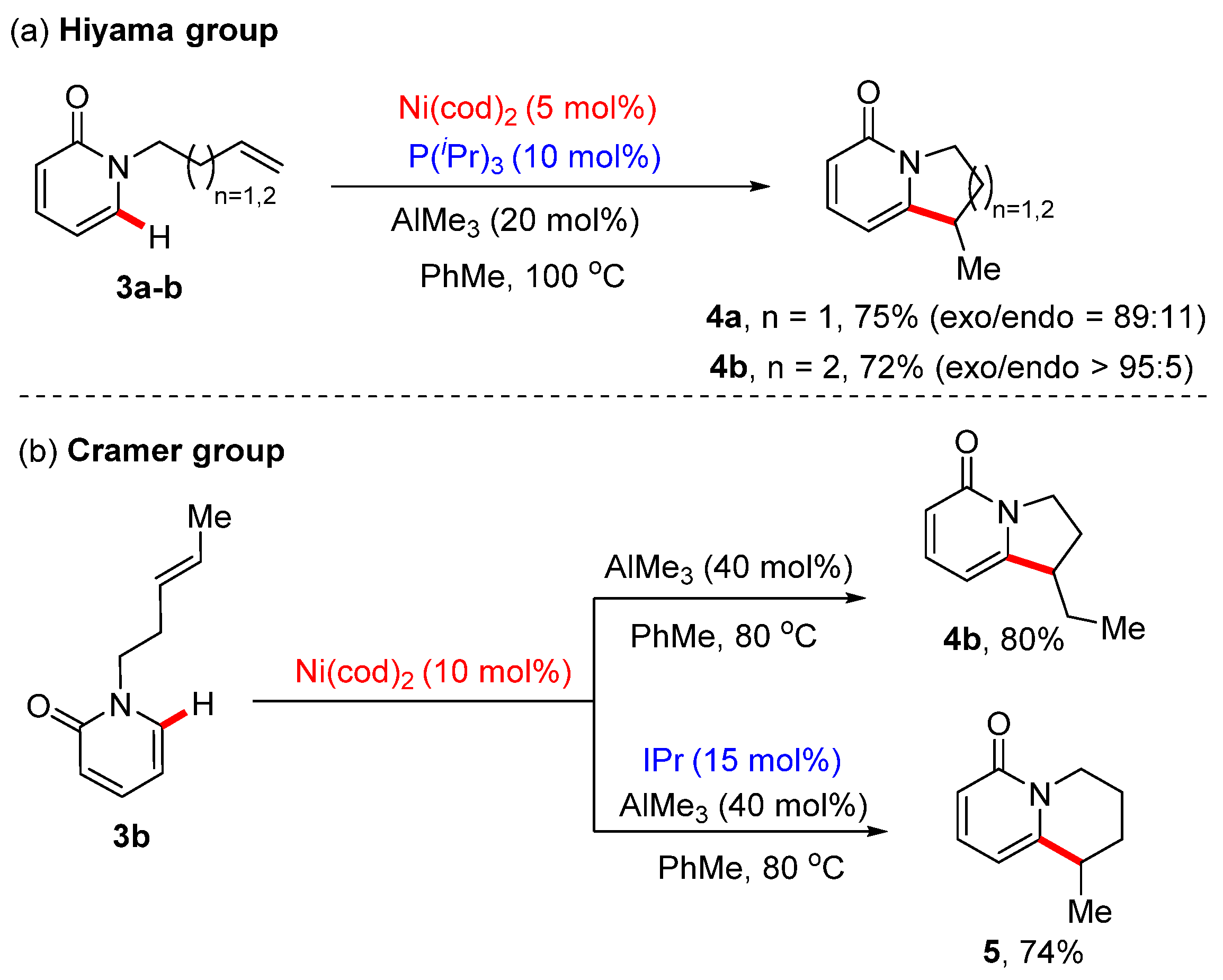






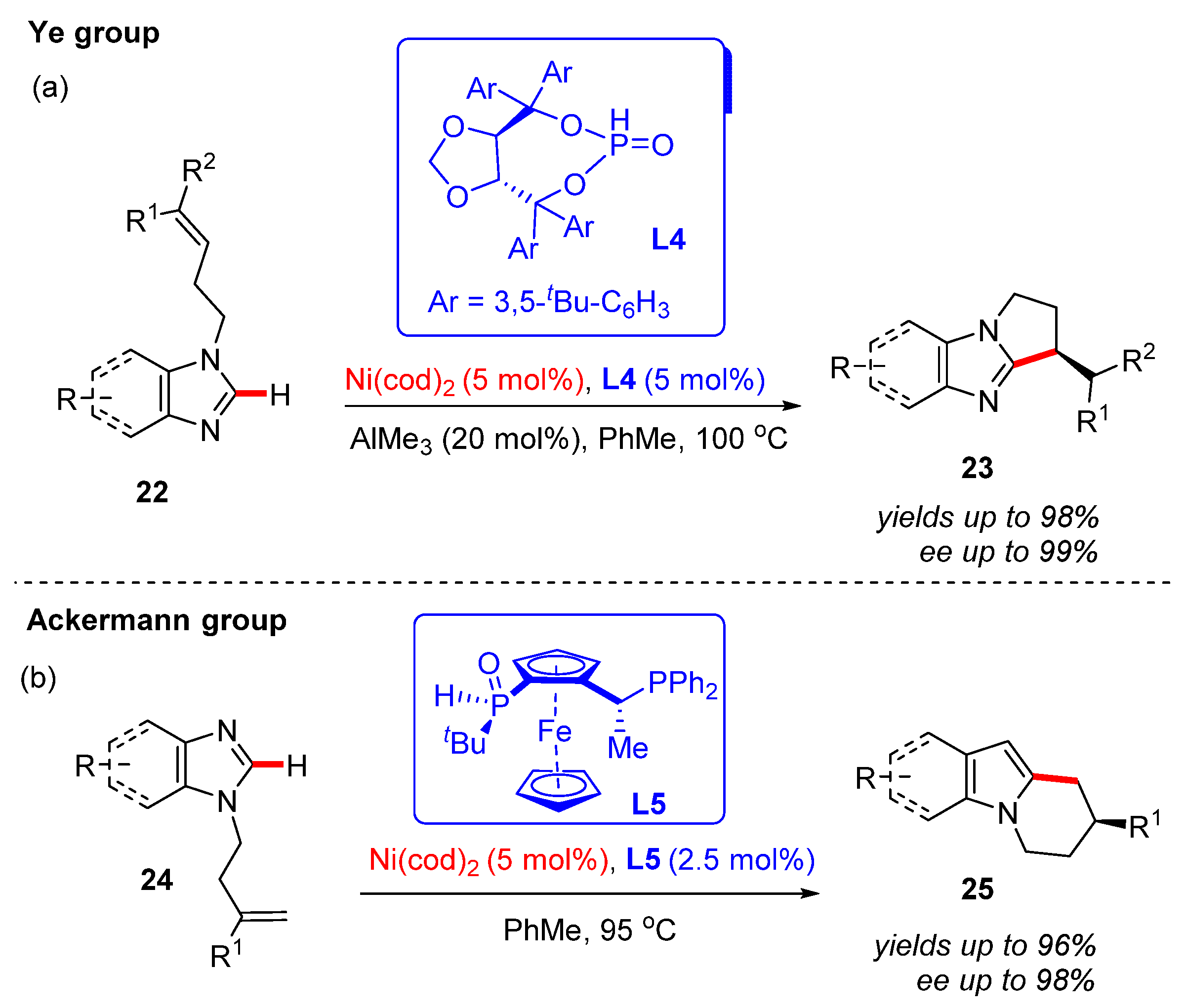
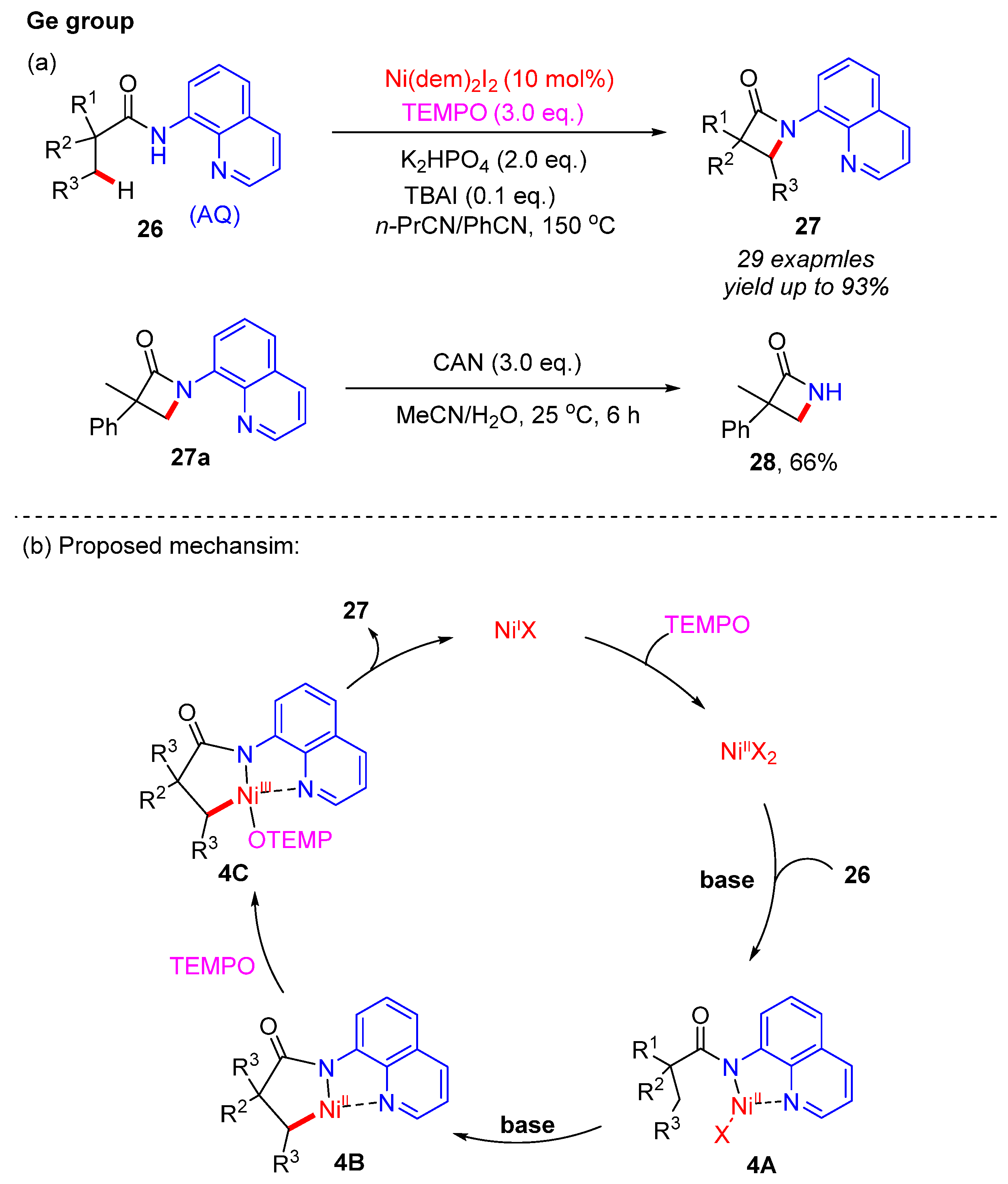

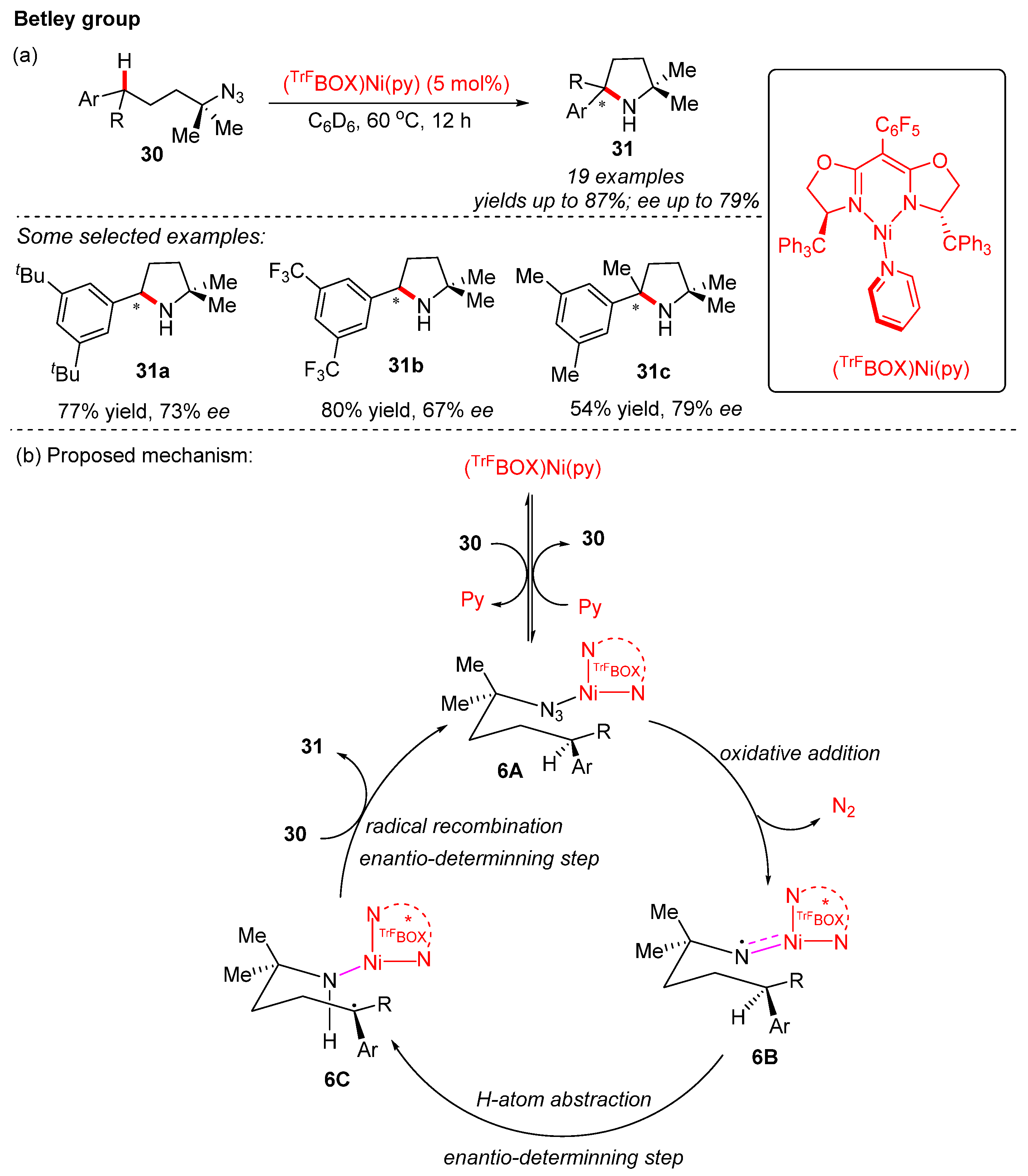

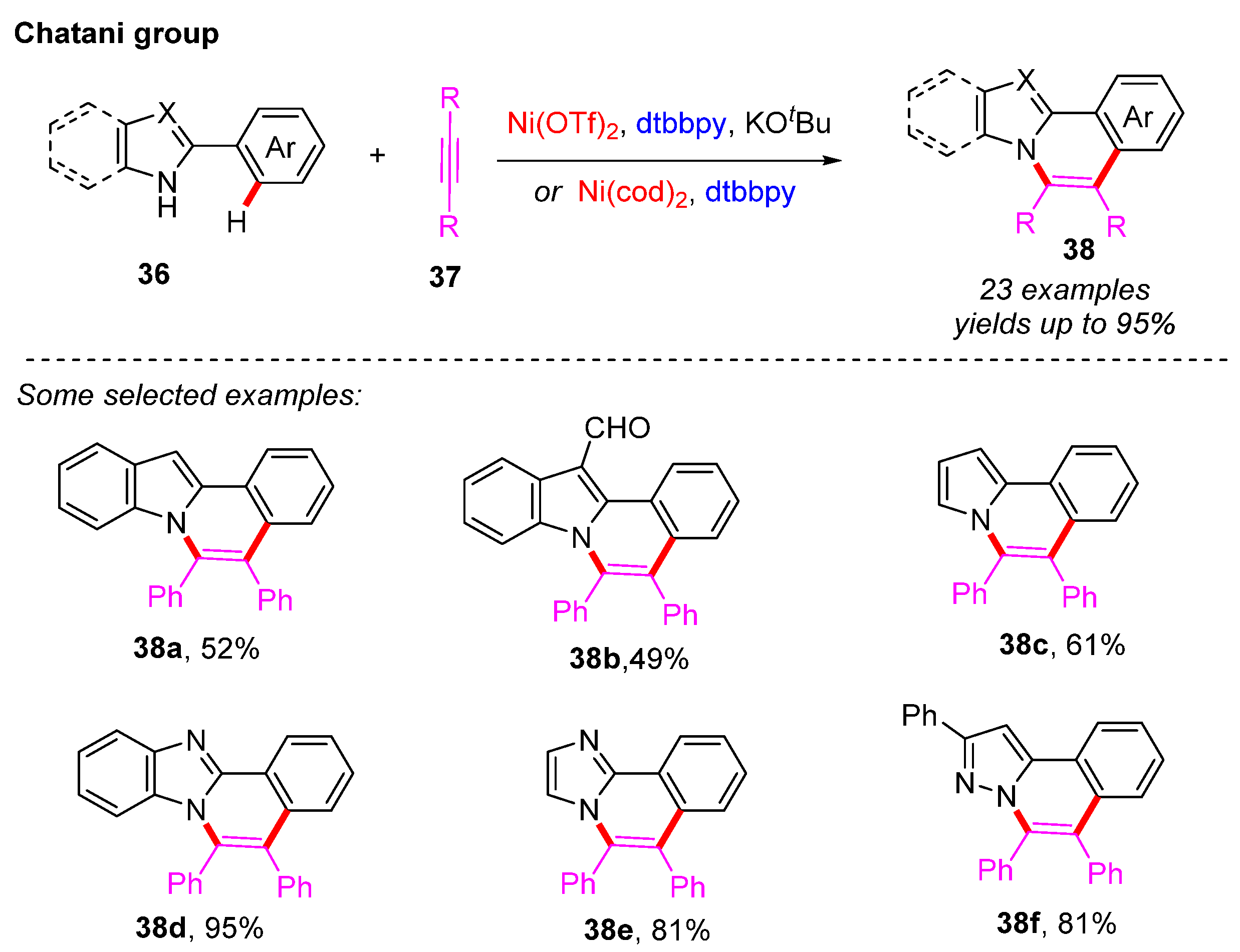
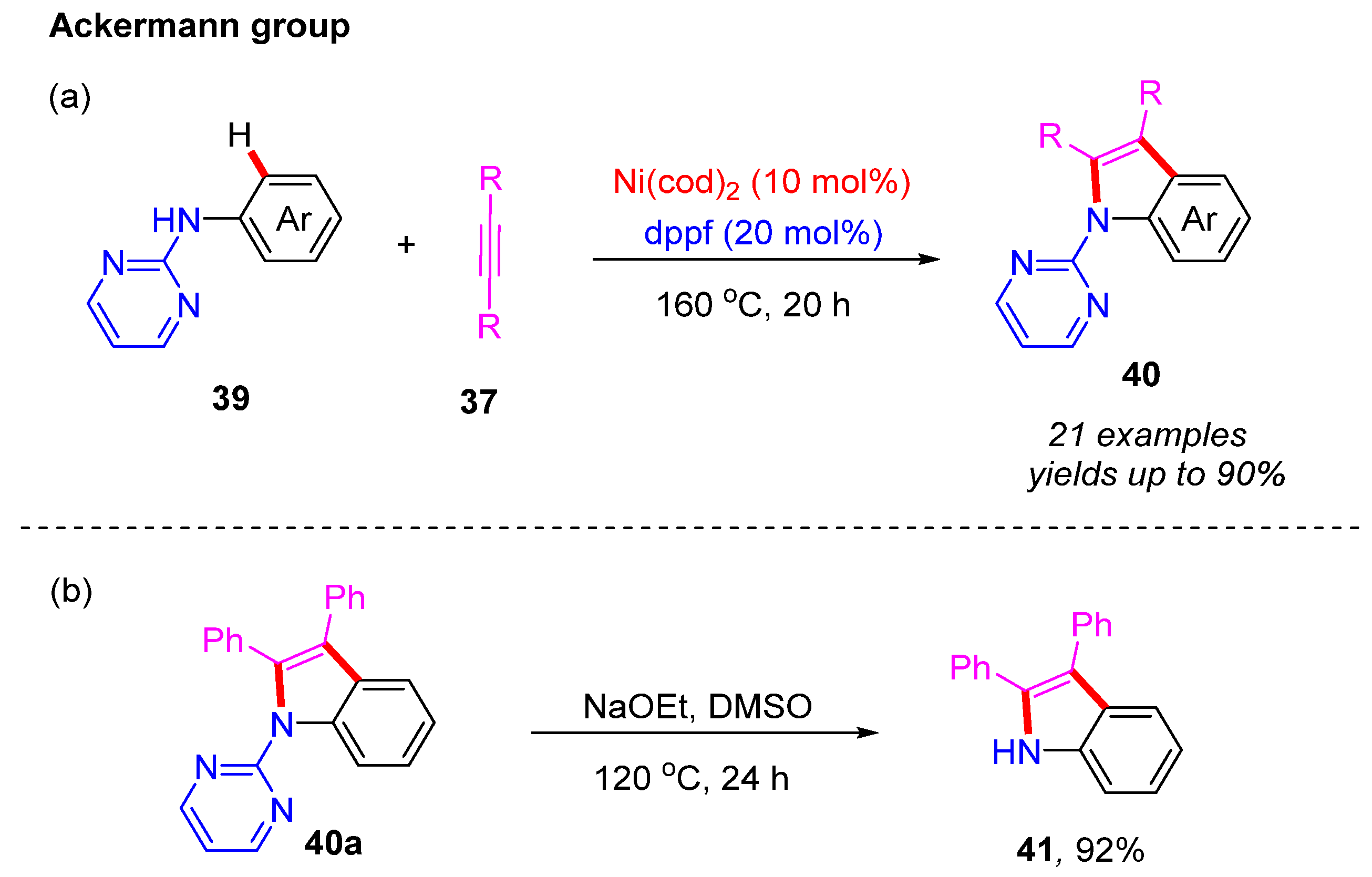
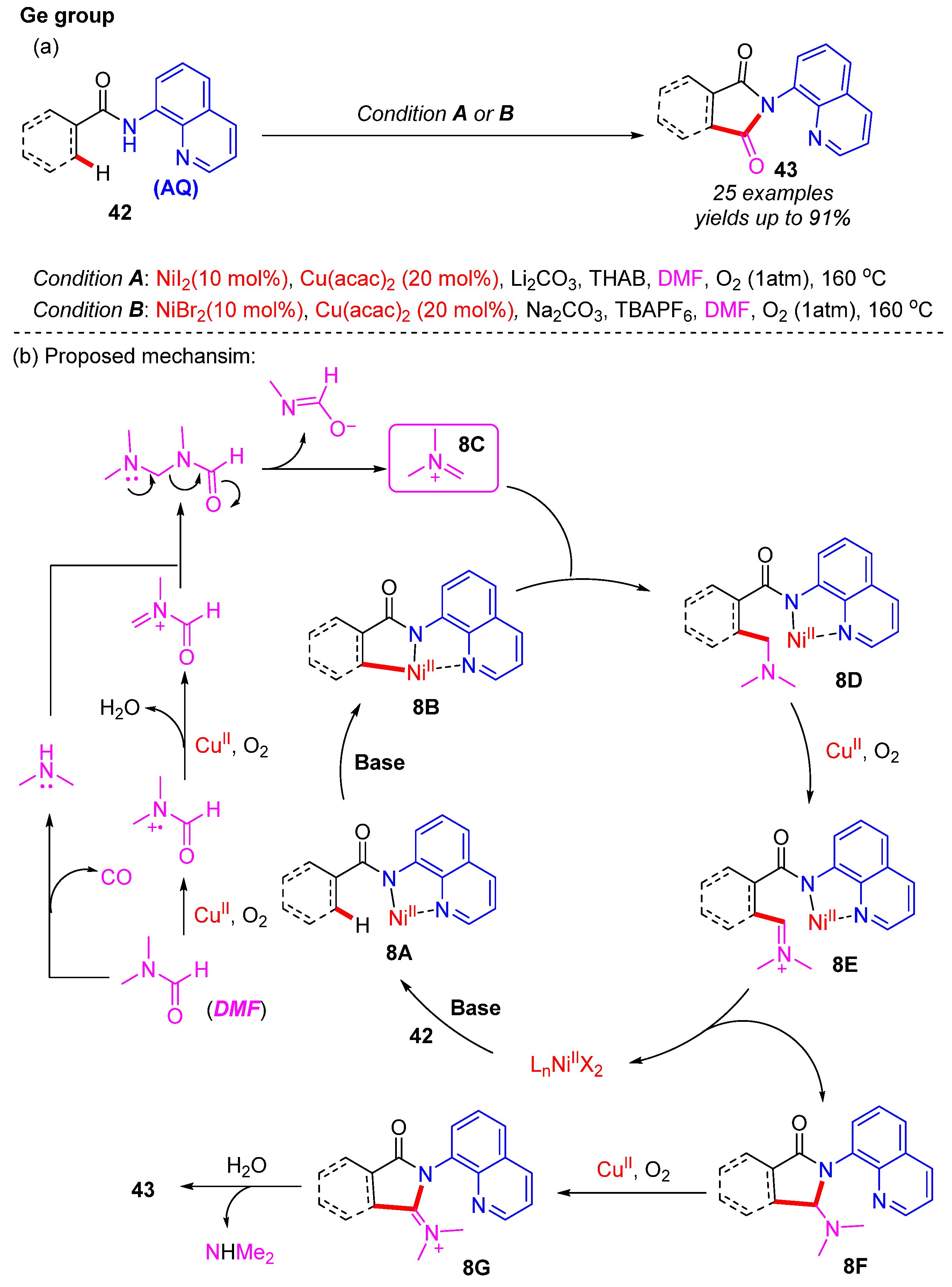


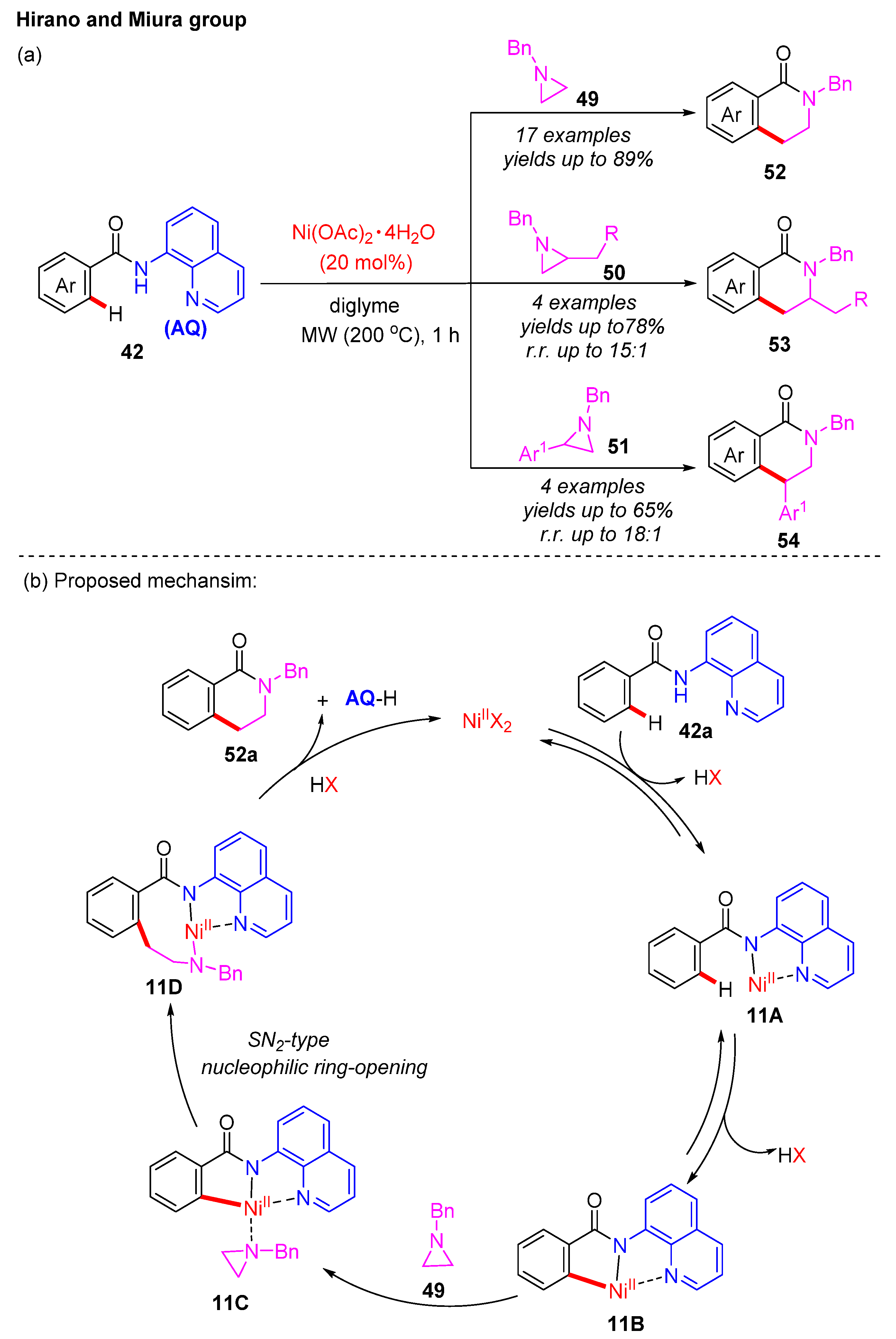
Publisher’s Note: MDPI stays neutral with regard to jurisdictional claims in published maps and institutional affiliations. |
© 2022 by the authors. Licensee MDPI, Basel, Switzerland. This article is an open access article distributed under the terms and conditions of the Creative Commons Attribution (CC BY) license (https://creativecommons.org/licenses/by/4.0/).
Share and Cite
Yang, K.; Li, Z.; Hu, Q.; Elsaid, M.; Liu, C.; Chen, J.; Ge, H. Recent Strategies in Nickel-Catalyzed C–H Bond Functionalization for Nitrogen-Containing Heterocycles. Catalysts 2022, 12, 1163. https://doi.org/10.3390/catal12101163
Yang K, Li Z, Hu Q, Elsaid M, Liu C, Chen J, Ge H. Recent Strategies in Nickel-Catalyzed C–H Bond Functionalization for Nitrogen-Containing Heterocycles. Catalysts. 2022; 12(10):1163. https://doi.org/10.3390/catal12101163
Chicago/Turabian StyleYang, Ke, Zhi Li, Qingyue Hu, Mazen Elsaid, Chong Liu, Jun Chen, and Haibo Ge. 2022. "Recent Strategies in Nickel-Catalyzed C–H Bond Functionalization for Nitrogen-Containing Heterocycles" Catalysts 12, no. 10: 1163. https://doi.org/10.3390/catal12101163
APA StyleYang, K., Li, Z., Hu, Q., Elsaid, M., Liu, C., Chen, J., & Ge, H. (2022). Recent Strategies in Nickel-Catalyzed C–H Bond Functionalization for Nitrogen-Containing Heterocycles. Catalysts, 12(10), 1163. https://doi.org/10.3390/catal12101163






